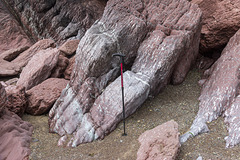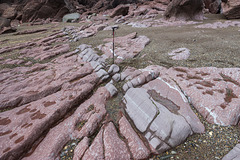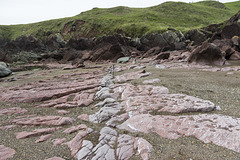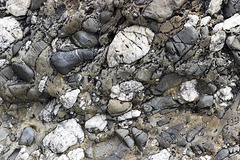
Pembrokeshire geology
Folder: Geology and Earth Science
Photos illustrating the geology of Pembrokeshire, west Wales.
Druidston Haven: Cliff Section 2
| |
|
Druidston Haven geology: Cliff Section 2
Photo No.2 of a series of six photos and interpretations to illustrate the geology of Druidston Haven, Pembrokeshire.
The cliffs of Druidston Haven mostly consist of Ordovician (Caradocian) age shales with some thin sandstones. During the Caledonian orgogeny at the end of the Silurian period, these were deformed into a series of mostly upright open folds. These were then re-folded by Variscan movements at the end of Carboniferous, to become largely recumbent (near horizontal) or partly inverted, facing down towards the south.
The Ordovician rocks form a horst - a ridge or block of strata faulted against younger rocks on either side. The Druidston Horst is bounded by the South Druidston Boundary Fault at the south end of the Haven, and the North Druidston Boundary Fault at the north end. These photos show the section midway along the horst from the stream to the Southern Boundary Fault at the far end.
Druidston Haven: Cliff Section 3 interpretation
| |
|
Druidston Haven geology: Cliff Section 3 interpretation
Interpretation No.3 of a series of six photos and interpretations to illustrate the geology of Druidston Haven, Pembrokeshire.
The cliffs of Druidston Haven mostly consist of Ordovician (Caradocian) age shales with some thin sandstones. During the Caledonian orgogeny at the end of the Silurian period, these were deformed into a series of mostly upright open folds. These were then re-folded by Variscan movements at the end of Carboniferous, to become largely recumbent (near horizontal) or partly inverted, facing down towards the south. The sandstone beds seen in this photo show irregular slumped bases and load casts, thus confirming that these beds young to the south (right).
The Ordovician rocks form a horst - a ridge or block of strata faulted against younger rocks on either side. The Druidston Horst is bounded by the South Druidston Boundary Fault at the south end of the Haven, and the North Druidston Boundary Fault at the north end. These photos show the section midway along the horst from the stream to the Southern Boundary Fault at the far end.
Druidston Haven: Cliff Section 3
| |
|
Druidston Haven geology: Cliff Section 3
Photo No.3 of a series of six photos and interpretations to illustrate the geology of Druidston Haven, Pembrokeshire.
The cliffs of Druidston Haven mostly consist of Ordovician (Caradocian) age shales with some thin sandstones. During the Caledonian orgogeny at the end of the Silurian period, these were deformed into a series of mostly upright open folds. These were then re-folded by Variscan movements at the end of Carboniferous, to become largely recumbent (near horizontal) or partly inverted, facing down towards the south. The sandstone beds seen in this photo show irregular slumped bases and load casts, thus confirming that these beds young to the south (right).
The Ordovician rocks form a horst - a ridge or block of strata faulted against younger rocks on either side. The Druidston Horst is bounded by the South Druidston Boundary Fault at the south end of the Haven, and the North Druidston Boundary Fault at the north end. These photos show the section midway along the horst from the stream to the Southern Boundary Fault at the far end.
Druidston Haven: Cliff Section 4 interpretation
| |
|
Druidston Haven geology: Cliff Section 4 interpretation
Interpretation No.4 of a series of six photos and interpretations to illustrate the geology of Druidston Haven, Pembrokeshire.
The cliffs of Druidston Haven mostly consist of Ordovician (Caradocian) age shales with some thin sandstones. During the Caledonian orgogeny at the end of the Silurian period, these were deformed into a series of mostly upright open folds. These were then re-folded by Variscan movements at the end of Carboniferous, to become largely recumbent (near horizontal) or partly inverted, facing down towards the south. The sandstone beds seen in this photo show irregular slumped bases and load casts, thus confirming that these beds young to the south (right).
The Ordovician rocks form a horst - a ridge or block of strata faulted against younger rocks on either side. The Druidston Horst is bounded by the South Druidston Boundary Fault at the south end of the Haven, and the North Druidston Boundary Fault at the north end. These photos show the section midway along the horst from the stream to the Southern Boundary Fault at the far end.
Druidston Haven: Cliff Section 4
| |
|
Druidston Haven geology: Cliff Section 4
Photo No.4 of a series of six photos and interpretations to illustrate the geology of Druidston Haven, Pembrokeshire.
The cliffs of Druidston Haven mostly consist of Ordovician (Caradocian) age shales with some thin sandstones. During the Caledonian orgogeny at the end of the Silurian period, these were deformed into a series of mostly upright open folds. These were then re-folded by Variscan movements at the end of Carboniferous, to become largely recumbent (near horizontal) or partly inverted, facing down towards the south. The sandstone beds seen in this photo show irregular slumped bases and load casts, thus confirming that these beds young to the south (right).
The Ordovician rocks form a horst - a ridge or block of strata faulted against younger rocks on either side. The Druidston Horst is bounded by the South Druidston Boundary Fault at the south end of the Haven, and the North Druidston Boundary Fault at the north end. These photos show the section midway along the horst from the stream to the Southern Boundary Fault at the far end.
Druidston Haven: Cliff Section 5 interpretation
| |
|
Druidston Haven geology: Cliff Section 5 interpretation
Interpretation No.5 of a series of six photos and interpretations to illustrate the geology of Druidston Haven, Pembrokeshire.
The cliffs of Druidston Haven mostly consist of Ordovician (Caradocian) age shales with some thin sandstones. During the Caledonian orgogeny at the end of the Silurian period, these were deformed into a series of mostly upright open folds. These were then re-folded by Variscan movements at the end of Carboniferous, to become largely recumbent (near horizontal) or partly inverted, facing down towards the south.
The Ordovician rocks form a horst - a ridge or block of strata faulted against younger rocks on either side. The Druidston Horst is bounded by the South Druidston Boundary Fault at the south end of the Haven, and the North Druidston Boundary Fault at the north end. These photos show the section midway along the horst from the stream to the Southern Boundary Fault at the far end.
Druidston Haven: Cliff Section 5
| |
|
Druidston Haven geology: Cliff Section 5
Photo No.5 of a series of six photos and interpretations to illustrate the geology of Druidston Haven, Pembrokeshire.
The cliffs of Druidston Haven mostly consist of Ordovician (Caradocian) age shales with some thin sandstones. During the Caledonian orgogeny at the end of the Silurian period, these were deformed into a series of mostly upright open folds. These were then re-folded by Variscan movements at the end of Carboniferous, to become largely recumbent (near horizontal) or partly inverted, facing down towards the south.
The Ordovician rocks form a horst - a ridge or block of strata faulted against younger rocks on either side. The Druidston Horst is bounded by the South Druidston Boundary Fault at the south end of the Haven, and the North Druidston Boundary Fault at the north end. These photos show the section midway along the horst from the stream to the Southern Boundary Fault at the far end.
Druidston Haven: Cliff Section 6 interpretation
| |
|
Druidston Haven geology: Cliff Section 6 interpretation
Interpretation No.6 of a series of six photos and interpretations to illustrate the geology of Druidston Haven, Pembrokeshire.
The cliffs of Druidston Haven mostly consist of Ordovician (Caradocian) age shales with some thin sandstones. During the Caledonian orgogeny at the end of the Silurian period, these were deformed into a series of mostly upright open folds. These were then re-folded by Variscan movements at the end of Carboniferous, to become largely recumbent (near horizontal) or partly inverted, facing down towards the south.
The Ordovician rocks form a horst - a ridge or block of strata faulted against younger rocks on either side. The Druidston Horst is bounded by the South Druidston Boundary Fault at the south end of the Haven, and the North Druidston Boundary Fault at the north end. This photo shows the southern end of the horst, terminated by the Southern Boundary Fault; a significant structure with a throw (displacement) of at least 1500 metres to the south, bringing Namurian 'Millstone Grit Series' (upper Carboniferous) rocks into contact with the Ordovician shales.
Druidston Haven: Cliff Section 6
| |
|
Druidston Haven geology: Cliff Section 6
Photo No.6 of a series of six photos and interpretations to illustrate the geology of Druidston Haven, Pembrokeshire.
The cliffs of Druidston Haven mostly consist of Ordovician (Caradocian) age shales with some thin sandstones. During the Caledonian orgogeny at the end of the Silurian period, these were deformed into a series of mostly upright open folds. These were then re-folded by Variscan movements at the end of Carboniferous, to become largely recumbent (near horizontal) or partly inverted, facing down towards the south.
The Ordovician rocks form a horst - a ridge or block of strata faulted against younger rocks on either side. The Druidston Horst is bounded by the South Druidston Boundary Fault at the south end of the Haven, and the North Druidston Boundary Fault at the north end. This photo shows the southern end of the horst, terminated by the Southern Boundary Fault; a significant structure with a throw (displacement) of at least 1500 metres to the south, bringing Namurian 'Millstone Grit Series' (upper Carboniferous) rocks into contact with the Ordovician shales.
East Pickard Bay panorama
| |
|
|
|
Freshwater West, Gravel Bay and East Pickard Bay
Moor Cliffs Formation at East Pickard Bay.
This photo was taken from coastal path and shows a general view of the upper part of the Moor Cliffs Formation at East Pickard Bay. The prominent ribs mark a series of tuffs (volcanic ash fall deposits) which can be used as stratigraphic markers. The sequence is dipping to the north (left) at approx. 50° - 65°. The headland of Linney Head is on the skyline in the right distance.
Panoramic view comprised of three landscape photos stitched together using Photoshop software.
Background:
The Moor Cliffs Formation overlies the Freshwater East conglomerates, seen in previous photos, and spans the boundary between the Silurian and Devonian periods. It consists of red mudstones and siltstones with occasional thin sandstone beds. These were deposited on a low-reflief floodplain at the edge of an arid continental margin, the sandstones being deposited by seasonal braided streams, the muds and silts deposited in ephemeral marginal lakes. When not inundated, the muds and silts developed carbonate-rich calcrete (caliche) soil horizons along dessication cracks, burrows and early plant root systems.
Gravel Bay - Moor Cliffs Formation
| |
|
|
Freshwater West, Gravel Bay and East Pickard Bay
Moor Cliffs Formation in Gravel Bay.
This photo was taken from coastal path and shows an easterly view of the wave cut platform in the Moor Cliffs Formation at the western end of Gravel Bay. Thin sandstone beds show up as greenish or purplish grey. The sequence is dipping to the north (left) at approx. 60° - 65°. The Blown Sand dunes of Broomhill Burrows are visible in the upper right.
Background:
The Moor Cliffs Formation overlies the Freshwater East conglomerates, seen in previous photos, and spans the boundary between the Silurian and Devonian periods. It consists of red mudstones and siltstones with occasional thin sandstone beds. These were deposited on a low-reflief floodplain at the edge of an arid continental margin, the sandstones being deposited by seasonal braided streams, the muds and silts deposited in ephemeral marginal lakes. When not inundated, the muds and silts developed carbonate-rich calcrete (caliche) soil horizons along dessication cracks, burrows and early plant root systems.
Gravel Bay - calcrete horizon in Moor Cliffs Forma…
| |
|
|
Freshwater West, Gravel Bay and East Pickard Bay
Moor Cliffs Formation in Gravel Bay.
This photo shows an even closer view of a calcrete soil development in mainly reddened mudstone beds in the Moor Cliffs Formation at the western end of Gravel Bay. The white mottled patches are irregular carbonate patches.
The lens cap is 72 mm in diameter.
Background:
The Moor Cliffs Formation overlies the Freshwater East conglomerates, seen in previous photos, and spans the boundary between the Silurian and Devonian periods. It consists of red mudstones and siltstones with occasional thin sandstone beds. These were deposited on a low-reflief floodplain at the edge of an arid continental margin, the sandstones being deposited by seasonal braided streams, the muds and silts deposited in ephemeral marginal lakes. When not inundated, the muds and silts developed carbonate-rich calcrete (caliche) soil horizons along dessication cracks, burrows and early plant root systems.
Gravel Bay - Moor Cliffs Formation with calcretes…
| |
|
|
Freshwater West, Gravel Bay and East Pickard Bay
Moor Cliffs Formation in Gravel Bay.
This photo shows a closer view of the mainly reddened mudstone beds in the Moor Cliffs Formation at the western end of Gravel Bay. The white mottling in the mudstones shows extensive calcrete soil horizons. The sequence is dipping to the north (right) at approx. 65°.
The walking stick is about 0.9 m long.
Background:
The Moor Cliffs Formation overlies the Freshwater East conglomerates, seen in previous photos, and spans the boundary between the Silurian and Devonian periods. It consists of red mudstones and siltstones with occasional thin sandstone beds. These were deposited on a low-reflief floodplain at the edge of an arid continental margin, the sandstones being deposited by seasonal braided streams, the muds and silts deposited in ephemeral marginal lakes. When not inundated, the muds and silts developed carbonate-rich calcrete (caliche) soil horizons along dessication cracks, burrows and early plant root systems.
Gravel Bay - Moor Cliffs Formation with calcretes…
| |
|
Freshwater West, Gravel Bay and East Pickard Bay
Moor Cliffs Formation in Gravel Bay.
This photo shows the mainly reddened mudstone beds in the Moor Cliffs Formation at the western end of Gravel Bay. The white mottling in the mudstones shows extensive calcrete soil horizons. The sequence is dipping to the north (right) at approx. 65°.
The walking stick is about 0.9 m long.
Background:
The Moor Cliffs Formation overlies the Freshwater East conglomerates, seen in previous photos, and spans the boundary between the Silurian and Devonian periods. It consists of red mudstones and siltstones with occasional thin sandstone beds. These were deposited on a low-reflief floodplain at the edge of an arid continental margin, the sandstones being deposited by seasonal braided streams, the muds and silts deposited in ephemeral marginal lakes. When not inundated, the muds and silts developed carbonate-rich calcrete (caliche) soil horizons along dessication cracks, burrows and early plant root systems.
Gravel Bay - millipede-like burrows in Moor Cliffs…
| |
|
|
Freshwater West, Gravel Bay and East Pickard Bay
Moor Cliffs Formation in Gravel Bay.
This photo shows a close-up view of the light purple sandstone bed with greenish laminae seen in the previous photo. The darker perpendicular features in the sandstone are trace-fossil Beaconites burrows. Having previously been tentatively ascribed to worm burrows or lung-fish burrows, they are now thought to have been made by primitive millipede-like animals.
The bed is approx. 50 cm thick (top to bottom) in this photo.
Background:
The Moor Cliffs Formation overlies the Freshwater East conglomerates, seen in previous photos, and spans the boundary between the Silurian and Devonian periods. It consists of red mudstones and siltstones with occasional thin sandstone beds. These were deposited on a low-reflief floodplain at the edge of an arid continental margin, the sandstones being deposited by seasonal braided streams, the muds and silts deposited in ephemeral marginal lakes. When not inundated, the muds and silts developed carbonate-rich calcrete (caliche) soil horizons along dessication cracks, burrows and early plant root systems.
Gravel Bay - Moor Cliffs Formation 2
| |
|
|
Freshwater West, Gravel Bay and East Pickard Bay
Moor Cliffs Formation in Gravel Bay.
This photo shows a closer view of the wave cut platform in the Moor Cliffs Formation at the western end of Gravel Bay. A light purple sandstone bed with greenish laminae is seen in the centre of the photo with red mudstones below (left) and above (right). The darker perpendicular features in the sandstone are trace-fossil Beaconites burrows. Having previously been tentatively ascribed to worm burrows or lung-fish burrows, they are now thought to have been made by primitive millipede-like animals.
The white mottling in the mudstones indicate extensive calcrete soil horizons. The sequence is dipping to the north (right) at approx. 60°.
The walking stick is about 0.9 m long.
Background:
The Moor Cliffs Formation overlies the Freshwater East conglomerates, seen in previous photos, and spans the boundary between the Silurian and Devonian periods. It consists of red mudstones and siltstones with occasional thin sandstone beds. These were deposited on a low-reflief floodplain at the edge of an arid continental margin, the sandstones being deposited by seasonal braided streams, the muds and silts deposited in ephemeral marginal lakes. When not inundated, the muds and silts developed carbonate-rich calcrete (caliche) soil horizons along dessication cracks, burrows and early plant root systems.
Gravel Bay - Moor Cliffs Formation 1
| |
|
Freshwater West, Gravel Bay and East Pickard Bay
Moor Cliffs Formation in Gravel Bay.
This photo shows the wave cut platform in the Moor Cliffs Formation at the western end of Gravel Bay. A light purple sandstone bed is seen in the centre of the photo with red mudstones below (left) and above (right). The white mottling towards the right is a particularly well-developed calcrete horizon. The sequence is dipping to the north (right) at approx. 60°.
The walking stick is about 0.9 m long.
Background:
The Moor Cliffs Formation overlies the Freshwater East conglomerates, seen in previous photos, and spans the boundary between the Silurian and Devonian periods. It consists of red mudstones and siltstones with occasional thin sandstone beds. These were deposited on a low-reflief floodplain at the edge of an arid continental margin, the sandstones being deposited by seasonal braided streams, the muds and silts deposited in ephemeral marginal lakes. When not inundated, the muds and silts developed carbonate-rich calcrete (caliche) soil horizons along dessication cracks, burrows and early plant root systems.
Conglomerate at Gravel Bay: close-up view 2
| |
|
|
Freshwater West, Gravel Bay and East Pickard Bay
Another close-up view of a conglomerate in the Freshwater East Formation (note name) at Gravel Bay, situated at the northern end of the large Freshwater West bay in south Pembrokeshire. The view is closely adjacent to the previous photo but without the lens cap for scale, as I didn't want it to distract from the lovely textures in this rock.
The vertical dimension of the photo is about 40 cm.
The Freshwater East Formation marks the beginning of 'Old Red Sandstone' type of sediments, formerly believed to be at the base of the Devonian, but now assigned to the uppermost Silurian. The pebbles and cobbles in the conglomerates mostly consist of white vein quartz and quartzite, grey sandstones and darker sitstones. These were depositied in an alluvial fan settting on a shallow floodplain in increasingly arid conditions.
Jump to top
RSS feed- Latest items - Subscribe to the latest items added to this album
- ipernity © 2007-2024
- Help & Contact
|
Club news
|
About ipernity
|
History |
ipernity Club & Prices |
Guide of good conduct
Donate | Group guidelines | Privacy policy | Terms of use | Statutes | In memoria -
Facebook
Twitter


















